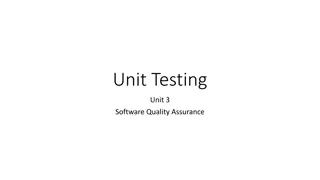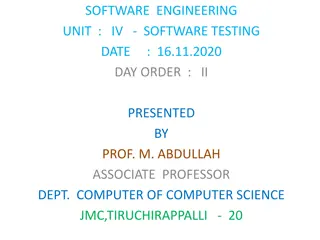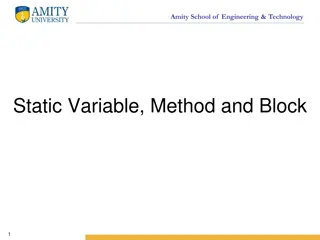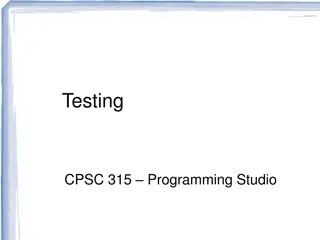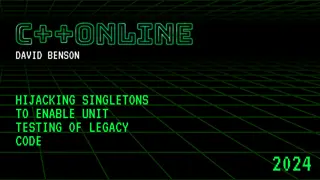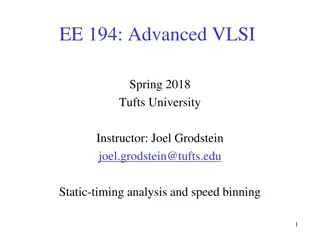Importance of Static Unit Testing in Software Development
Unit testing is a crucial aspect of software development, involving both static and dynamic approaches. Static unit testing, such as code inspections and walkthroughs, helps in finding errors early, reducing costs and improving reliability. By examining code behavior against requirements and involving a team of experts for inspections, developers can enhance the quality of their software significantly.
Download Presentation

Please find below an Image/Link to download the presentation.
The content on the website is provided AS IS for your information and personal use only. It may not be sold, licensed, or shared on other websites without obtaining consent from the author. Download presentation by click this link. If you encounter any issues during the download, it is possible that the publisher has removed the file from their server.
E N D
Presentation Transcript
Chapter Four: Unit Testing Sem. II - 2020 Department of Software Engineering ITSC-AAIT Dr. Sunkari Software Verification and Validation 1
Concept of Unit Testing A unit test generally exercises the functionality of the smallest possible unit of code (which could be a method, class, or component) in a repeatable way. Static Unit Testing Code is examined over all possible behaviors that might arise during run time Code of each unit is validated against requirements of the unit by reviewing the code Dynamic Unit Testing A program unit is actually executed and its outcomes are observed. One observe some representative program behavior, and reach conclusion about the quality of the system Static unit testing is not an alternative to dynamic unit testing. Both are complementary in nature. Software Verification and Validation 2
Static Unit Testing Static Testing techniques are quite effective in finding errors - so much so that every programming project should use one or more of these techniques. How these testing techniques contribute to productivity and reliability the earlier errors are found, the lower the costs of correcting the errors and the higher the probability of correcting the errors correctly. programmers seem to experience a psychological change when computer-based testing commences. The two primary static testing methods are code inspections and walkthroughs. Software Verification and Validation 3
Inspections and Walkthroughs Involve a team of people reading or visually inspecting a program Requires subsequent meeting to find errors but not to find solutions to the errors (to test rather than to debug). Is an improvement over the desk-checking process. Review is conducted by three or four experts, only one is the author who revises his/her code based on test standards. lower debugging (error-correction) costs. In Contrast, Computer based testing Uncovers 30 - 70 percent of logical and coding errors but not higher level design errors. Software Verification and Validation 4
Code Inspections A code inspection is a set of procedures and error-detection techniques for group code reading. Inspection team is composed of three-four members; one as a moderator. moderator Distributes materials for (several days in advance), and scheduling, the inspection session, Leading the session, Recording all errors found, and ensuring that the errors are subsequently corrected. Activities during inspection session Narrating the code programmer is responsible Analyzing the program based on a checklist which is composed of historically common programming errors. Software Verification and Validation 5
Code Inspections Benefits The programmer usually receives feedback concerning programming style, choice of algorithms, and programming techniques. The same is true for other members. Guides computer based testing by narrowing the domain to be tested (get the flash point). Software Verification and Validation 6
Error Checklist for Inspections The checklist is largely language independent, meaning that most of the errors can occur with any programming language. The following categories of checklists are recommended based on a through research on the domain [read ref. book to know Qs. Under each category] Data Reference Errors Data-Declaration Errors Computation Errors Comparison Errors Control-Flow Errors Interface Errors Input/output Errors Software Verification and Validation 7
Walkthroughs Similar to Inspections process but different In the procedure of the meeting and error-detection technique. The team should have a tester, moderator, secretary and experienced programmer/s. Procedure The tester comes to the meeting armed with a small set of paper test cases. Each test case is mentally executed (the test data are walked through the logic of the program) State of the program is monitored on a paper/ white board. Test Cases here are not a way to uncover error but as a vehicle for getting started and for questioning the programmer about his or her logic and assumptions. Software Verification and Validation 8
Desk Checking can be viewed as a one-person inspection or walkthrough A person reads a program, checks it with respect to an error list, and/or walks test data through it. Less Effective completely undisciplined process. people are generally ineffective in testing their own programs. Swapping programs between programmers and let other check your unit. Still ineffective Synergetic effect of the walkthrough or inspection team Software Verification and Validation 9
Dynamic Unit Testing Dynamic unit testing is a term used to describe the testing of dynamic behavior of code based on specific test cases by execution of the test object or running programs. The environment of a unit is emulated and tested in isolation The caller unit is known as test driver A test driver is a program that invokes the unit under test (UUT) It provides input data to unit under test and report the test result The emulation of the units called by the UUT are called stubs It is a dummy program The test driver and the stubs are together called scaffolding The low-level design document provides guidance for selection of input test data. Software Verification and Validation 10
Dynamic Unit Testing Software Verification and Validation 11
Test Case Design Selection of test data is broadly based on the following techniques: Control Flow Testing Draw a control flow graph (CFG) from a program unit Select a few control flow testing criteria Identify a path in the CFG to satisfy the selection criteria Derive the path predicate expression from the selected paths By solving the path predicate expression for a path, one can generate the data Software Verification and Validation 12
Test Case Design Data Flow Testing Draw a data flow graph (DFG) from a program unit and then follow the procedure described in control flow testing. Domain Testing Domain errors are defined and then test data are selected to catch those faults. Functional program Testing Input/output domains are defined to compute the input values that will cause the unit to produce expected output values Software Verification and Validation 13
Mutation Testing Modify a program by introducing a single small change to the code A modified program is called mutant A mutant is said to be killed when the execution of test case cause it to fail. The mutant is considered to be dead. A mutant is an equivalent to the given program if it always produce the same output as the original program. A mutant is called stubborn, if the existing set of test cases is insufficient to kill it. A mutation score for a set of test cases is the percentage of non-equivalent mutants killed by the test suite. The test suite is said to be mutation-adequate if its mutation score is 100%. Software Verification and Validation 14
Mutation Testing Mutation analysis is a two step process The adequacy of an existing test suite is determined to distinguish the given program from its mutants. Stubborn Mutants are identified. Additional test cases will be added to kill stubborn mutants. Mutation testing makes two major assumptions: Competent Programmer hypothesis Programmers are generally competent and they do not create random programs Coupling effects Complex faults are coupled to simple faults in such a way that a test suite detecting simple faults in a program will detect most of the complex faults Software Verification and Validation 15
Debugging Debugging is a two-step process that begins when you find an error as a result of a successful test case. Step 1 is the determination of the exact nature and location of the suspected error within the program. Step 2 consists of fixing the error. It is less enjoyable phase in software product development Your ego may get in the way. You may run out of steam. You may lose your way. You may be on your own. Software Verification and Validation 16
Debugging by Brute Force Is the least mentally taxing, but inefficient and generally unsuccessful method. Brute force methods can be partitioned into at least three categories: Debugging with a storage dump. a crude display of all storage locations in hexadecimal or octal format) The most inefficient form of debugging Debugging according to the common suggestion to scatter print statements throughout your program (hit-or-miss method.). Debugging with automated debugging tools. has the ability to set breakpoints that cause the program to be suspended when a particular statement is executed. Software Verification and Validation 17
Debugging by Induction a disciplined thought process without ever going near the computer. start with the clues (the symptoms of the error, possibly the results of one or more test cases) and look for relationships among the clues. Software Verification and Validation 18
Debugging by Deduction is a process of proceeding from some general theories or premises, using the processes of elimination and refinement, to arrive at a conclusion. Software Verification and Validation 19
Debugging by Backtracking Start at the point where the program gives the incorrect result such as where incorrect data were printed. At this point you deduce from the observed output what the values of the program's variables must have been. By performing a mental reverse execution of the program from this point and repeatedly using the process of "if this was the state of the program at this point, then this must have been the state of the program up here," you can quickly pinpoint the error. Software Verification and Validation 20
Debugging by Testing Test Cases for Debugging vs Test Cases for Testing while debugging, the purpose is to provide information useful in locating a suspected error Fat Vs Slim Test Case Test Cases for debugging should be slim where you want to cover only a single condition or a few conditions in each test case. Can be used with induction method (to collect information to collect data) and deduction method (to eliminate suspected causes). Read Debugging Principles Software Verification and Validation 21
Extreme Testing XP is a software development methodology which is intended to improve the software quality and responsiveness to the level of customers requirement and it encourages frequent releases in short development cycles. XP was likely developed to support the adoption of programming languages such as Java, Visual Basic, and C#. XP differs from traditional development processes it avoids the large-scale project syndrome it avoids coding unneeded functionality ( helps required functionality) it focuses on testing write test then code to satisfy the test. Software Verification and Validation 22
Extreme Testing XP concepts/practices Listening to the customer and other programmers. Collaborating with the customer to develop the application s specification and test cases. Pair Programming Testing the code base (XT). Different from Unit Testing (Test Written Before Coding) Software Verification and Validation 23
Extreme Unit Testing Unit Testing and Acceptance Testing are the two extreme testing techniques. Pick a requirement, i.e., a story Write a test case that will verify a small part of the story and assign a fail verdict to it Write the code that implement particular part of the story to pass the test Execute all test Rework on the code, and test the code until all tests pass Repeat step 2 to step 5 until the story is fully implemented Software Verification and Validation 24
Extreme Unit Testing Three laws of Test Driven Development (TDD) One may not write production code unless the first failing unit test is written One may not write more of a unit test than is sufficient to fail. One may not write more production code than is sufficient to make the failing unit test pass. Pair programming: In XP, code is being developed by two programmers working side by side One person develops the code tactically and the other one inspects it methodically by keeping in mind the story they are implementing. Software Verification and Validation 25
JUnit A Framework for Unit Testing JUnit: It is a framework for performing unit testing of Java programs. Other frameworks: NUnit (C#), CPPUnit (C++), fUnit (Fortran) Intuitive steps to test a method in Java (Ex. Move() method of PlanetClass) Create an object instance of PlanetClass. Call it Mars. Select values of all input parameters of Move(). Compute the expected value to be returned by Move(). Let it be y. Execute method Move() on Mars with the selected input values. Let Move() return a value called z. Compare the actual output (z) returned by Move() with the expected value (y). If (z == y), Move() passes the test; otherwise it fails. ? Report the result. Software Verification and Validation 26
Reading Software Testing and Quality Assurance: Theory and Practice Page [83-120] Glenford J. Myers, The Art of Software Testing , John Wiley & Sons, Inc., 2nd Ed., 2004. Page [21-43, 91-105, 157-193] And read other related sites Software Verification and Validation 27



